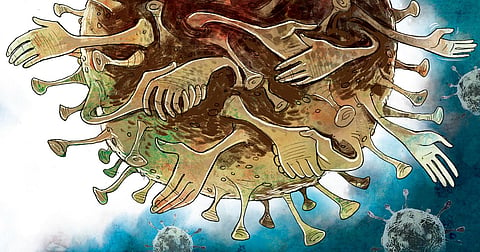

In addition to yoga, another aspect of traditional Indian lifestyle—greeting others with a namaste or namaskar—is storming the globe. This is since the world has not been left with many options in the time of the deadly and contagious coronavirus epidemic. Physicians and world leaders are advising the people to minimise social contact. And Israeli Prime Minister Benjamin Netanyahu and US President Donald Trump, while advising people to avoid handshakes, even demonstrated how Indians greet each other with a namaste.
There are several traditional ways of greeting—from tipping the hat, kissing the cheek, shaking hands to hugging—in different countries of the world. Photos of the French President Emmanuel Macron greeting the US First Lady Melania Trump by kissing her hand, or some top political leader kissing the hand of the Pope have found place in the pages of newspapers. Special types of localised greetings include the snapping fingers handshake of Nigeria, the traditional Maori greeting of New Zealand called hongi (pressing nose and forehead to those of another person), pressing ‘nose to nose’ as in the UAE, Qatar, Oman and Yemen.
The history of the handshake dates back to 5th century BCE in Greece, and it symbolises that both the persons are not holding any kind of weapon in their hands. Today, amid the outbreak of coronavirus, people are afraid of such physical contact as this might compromise their hygiene to a great extent. In early March, German Chancellor Angela Merkel, while attending a summit in Berlin, approached her interior minister Horst Seehofer for a handshake. The minister smiled and refused to shake hands with the Chancellor and kept his hands to himself. Some were very cautious regarding hand contact even earlier. The New York Times columnist Maureen Dowd wrote about how when she interviewed Donald Trump during his 2016 presidential race, the latter had a big hospital-strength bottle of hand sanitiser on the table.
Handshakes are known to spread a number of microbial pathogens, due to skin-to-skin contact. There are several academic studies in different parts of the globe to study how germs spread through handshakes. In a 2014 article in the journal American Journal of Infection Control, two researchers—Sara Mela and David E Whitworth—illustrated that a handshake transfers an average of 124 million colony-forming units of Escherichia coli— almost twice as high as that during high-fives and about 20 times more than in the case of fist bumps. In fact, handshakes cover a large contact area—24.4 square inches, and also last longer (three seconds, on an average) than high-fives or fist bumps.
Earlier, during the 2009 H1N1 pandemic, Thomas Feasby, the dean of medicine at the University of Calgary, Canada, suggested that fist bumps may be a “nice replacement of the handshake” to prevent transmission of the virus. In a 2009 article in BMJ, one of the world’s oldest general medical journals, Malvinder S Parmar of the Northern Ontario School of Medicine opined against handshakes by mentioning that “it is time to re-think this form of greeting or salutation to avoid unnecessary physical contact and proximity among people”. Parmar advocated the use of the Indian-style namaste instead, as an example of a greeting where “close physical contact is avoided without causing insult or negative feelings among the parties involved”.
Today, red billboards in Beijing are promoting the practice of clasping one’s own hands in greeting. The traditional gong shou gesture of placing one’s fist in one’s palm is advised across China. The UAE and Qatar are all out to stop using the traditional ‘nose to nose’ style of greeting. The UAE is recommending greeting each other ‘by waving only’. France is desperately advocating against any form of kissing to greet. Lifestyle expert Philippe Lichtfus has gone on to opine that even simply looking into a person’s eyes can suffice as a greeting.
Is the triumph of namaste inevitable now? It certainly has competitors. The Japanese ‘bow’, for example. Depending on the angle of inclination, the bow is called eshaku (15 degree), keirei (30 degree) or saikeirei (45 to 70 degree). The Thai wai seems to be a combination of Indian namaste and Japanese bow, where the palms are placed together at the chest and the head is bowed so that the thumbs touch the chin and fingertips touch the forehead. The Cambodian style of greeting, called sampeah, is very similar to the Thai wai. In fact, both wai and sampeah are based on the Indian anjali mudra, which is again the basis of the Indian namaste. This has been propagated to Southeast Asia through the spread of Hinduism and Buddhism from India. Namaste is derived from Sanskrit, the term namas being found in the Rig Veda, while namahḥ means ‘bow’, ‘obeisance’, ‘reverential salutation’ or ‘adoration’. Te, of course, means ‘to you’.The British newspaper The Guardian has already pronounced ‘The end of the handshake’. As the namaste culture spreads around the world, one wonders about the future of cultural gestures like touching the feet and hugging, amid fear of skin-to-skin transmission of microbes.
Atanu Biswas
Professor of Statistics at the Indian Statistical Institute, Kolkata Email: atanu@isical.ac.in